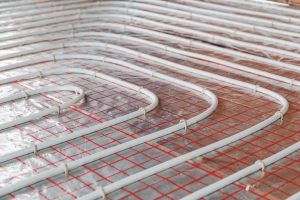Utility bills are expected to climb as outdoor temperatures drop, and keeping your home warm during the winter can cost you. At Signature Homes, we build the perfect home for every season. In addition to proper insulation and ventilation, some homeowners are turning to heated flooring options. But, are they worth the investment? We investigated the pros and cons of heated flooring. This what we found.

Heated, or radiant flooring comes in two different forms: electric and hydronic. Both options can be controlled by a thermostat. Electric heating elements are woven into the flooring of electric heating systems. They’re easier to install and can be placed during room remodeling projects. Hydronic radiant flooring, on the other hand, is more difficult to install than electric flooring and is usually added during initial home construction. Hydronic radiant flooring is more ideal for whole-house heating than electric heated flooring and works by pumping hot water through plastic tubing beneath the floor.
Pros
- Energy-Efficient
While vented heating systems can allow air to escape, heated floors create a warmth that can be retained. They also warm the people and objects in a room, rather than the air around them, meaning less heat will need to be generated overall. While environmentally friendly, it’s also cost-effective. Radiant flooring could cut your heating bill by more than 15%.
- Maintenance-Free
Heated flooring requires no maintenance once installed. In the rare case of cable damage during installation of electric radiant floors, a thermal imaging camera can be used to locate and repair the issue.
- Allergy-Friendly
Vent-based heating systems can stir up dust and other allergens when blowing hot air into a room. Heated floors eliminate this risk by heating the ground without the use of air.
Cons
- Cost

The installation of heated flooring is typically more expensive than ordinary flooring options. Expect to pay anywhere between $10 to $20 per square foot for labor and materials. Radiant flooring may increase a monthly electric bill if using electric and not hydronic flooring, but will likely be offset by the decrease in your gas bill for heating the home.
- Floor Replacement
If you’re installing radiant flooring, existing flooring must be removed. Heated floors cannot be installed below or above ordinary flooring. If remodeling or building a new Signature home, the installation will happen at the time of construction.
- Floor Height
Electric radiant flooring will raise the height of your floors by about ½ an inch, and hydronic flooring will raise it a bit more. If adding insulation below the floor to allow heat to travel up, rather than down, expect a full inch of additional height. You’ll need to accommodate this with door heights and ensure it’s not a tripping hazard.
If radiant floors just aren’t for you, there are other flooring options available to help keep your home warm. Carpet and cork are both great choices to have underfoot, while vinyl and laminate pair well over other options for warmth. Tile, however, can chill your feet and make a home feel cold. Pair colder floors with rugs to warm room space.
Your Signature home should feel comfortable in every season. Contact us today to learn about the best flooring options available for building the home of your dreams in 2020.



